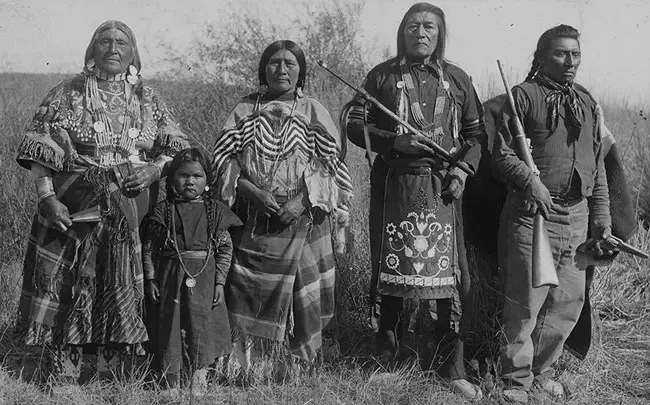


Because the Aboriginal lives did not change outside of missions, the task of converting Aborigines was often difficult. For conversion to be effective, the natives had to be isolated from their traditional culture. John Eliot, an English Puritan missionary, brought this idea to an unmistakable point in 1650. In Natick, south of Boston, he established a "red puritan" settlement for the converts, following the principles of his community - a religious colony. The community was built in English style, with a temple and a gateway to cross the river. Locals banned native practices such as polygamy, seasonal migrations, and shamanic cures, and replaced hereditary leadership with representatives elected in the English way.
The idea quickly spread across the coast and another twenty “cities of prayer” were established. They only existed until 1675, when the devastating war between the Puritans and the alliance of wampanoags and narragansets erupted.
The European imagines the past as a long, straight path that goes back from the present to a distant, invisible place on the horizon. It appears to be a strange place, far from its ancestors, including its own. It is important to note that many indigenous groups believe that time is not linear but circular and is characterized by the birth, development, maturity, death and regeneration of everything that shares the earth: plants, animals and humans. The sunrise and sunset, as well as the solar and lunar cycles, follow this pattern. All things that have completed the cycle live in the past. At present, these situations are present and are not temporary, but persistent.
Whatever their cultural tradition, Native Americans believe that sunrise and sunset are the fundamental rhythm of everyday life, which is what most people believe. Native Americans record the passage of longer periods in a variety of ways and often follow a natural calendar whose markers reflect changes in their environment. For example, while desert inhabitants await the ripening of the fruits of the sage, the salmon's dew is a key seasonal marker for the villages on the northwest coast. In many cultures, the life of communities follows the natural rhythms. It is customary among the Iroquois to celebrate the arrival of spring, summer and autumn with the flowering of the arches (from February to March), the appearance of the first strawberries (in June) and the ripening of the corn harvest (en octubre).
In addition, it is possible that some peoples used the observation of the position of celestial bodies to measure time. It is possible that the mysterious "medical wheels" of the northern plains are used to predict astronomical displacements.
 Native American Cultures: Myths and magic
Native American Cultures: Myths and magic
You can purchase this book on Amazon.
This book challenges deep-seated stereotypes and offers an enriching perspective that contributes to a more comprehensive and respectful appreciation of the indigenous peoples of North America. Through an understanding of their myths and beliefs, we are taking an important step toward cultural reconciliation and the recognition of the diversity that has enriched the history of this continent.
These mythical stories, many of them linked to the literary genre of fantasy, reveal a world where the divine and the human intertwine in narratives that explain the cosmic order, creation, and the fundamental structure of the universe. Discover how these sacred tales bear witness to the deep connection of the natives with nature and spirituality.
Native Americans: Population and Territories
Native Americans: Cultures, customs, worldview
Traditions, myths, stories and legends